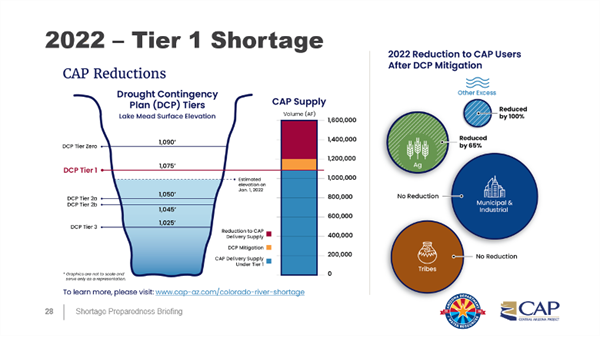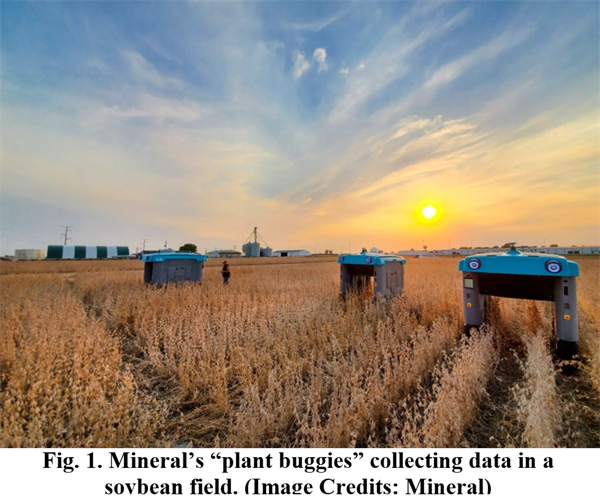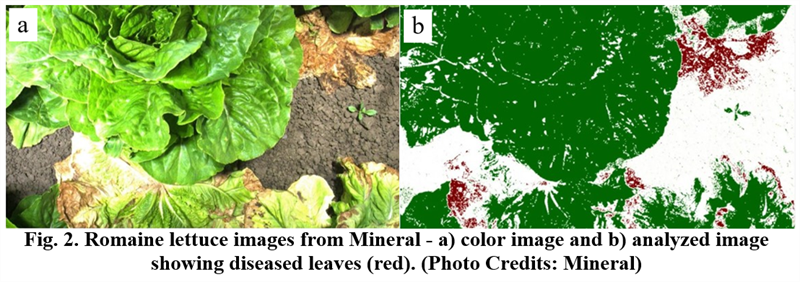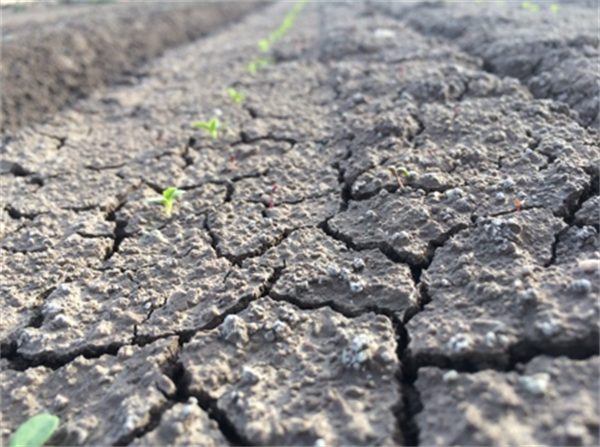
For those of us living in the desert, particularly working in agriculture, we commonly use rather affectionate terms to describe water. Water is often referred to as the “life blood” of the desert and we know that “water is life” and it is the most critical limiting factor in any desert crop production system. It is important for everyone in Arizona agriculture to be aware of our water supplies and the prospects for the future.
As the population has grown in the desert Southwest, the demands on our water resources have increased substantially. This has been exacerbated by two decades of drought and increasing average temperatures. As a result, Arizona water supplies have become increasingly critical in terms of both short and long-term capacities.
Continual reviews are being conducted by the Arizona Department of Water Resources (ADWR) and the Central Arizona Project (CAP) and other Arizona agriculture groups regarding Arizona water supplies, specifically from the Colorado River, which supports, at least in part, more than 80% of the Arizona population. The system-wide effort to stabilize the Lake Mead water supply with the 2019 Drought Contingency Plan (DCP) seems to be working as intended to help forestall drops in the reservoir’s levels. However, it does not remove all risk of continually lowering water supplies in Lake Mead.
The DCP for the lower basin of the Colorado River, below Lake Powell, is a set of shortage-sharing agreements among the Lower Basin States of Arizona, California, and Nevada. The DCP augments the 2007 shortage-sharing agreements put in place by the states who are dependent on the Colorado River.
On 16 August 2021, the Bureau of Reclamation declared that Lake Mead will be in a Tier One shortage level beginning 2022. The elevation of the lake is and will continue to be below 1,075 feet above sea level. As a result, Arizona will now be subject to significant cuts in water deliveries from the Colorado River based on Tier 1 reductions in water allocations, that are part of the DCP, and this will go into effect in January 2022 (Figure 1). This will result in Arizona reducing Colorado River water use by 512,000 acre-feet (AF), or 18% of Arizona’s total allocation of 2.8 AF. Tier 1 reductions primarily impact the CAP water allocations, which will be reduced by 30%. Under Tier 1 reductions, agricultural CAP water allocations will be reduced by 65%, primarily affecting Pinal County agriculture. Statewide municipal & industrial and tribal allocations will not be reduced under Tier 1 guidelines. Yuma area water allocations will not be reduced under Tier 1.
We continue to monitor Lake Mead conditions and if lake levels drop to 1,050 and 1,045 ft., we will enter Tier 2 (a and b, respectively) conditions which will increase total reductions of Colorado River water to Arizona to 590,000 and then 640,000 AF, or 21 and then approximately 23% of Arizona’s total allocation. The ADWR provides a good source of information and the prospects on these changing conditions.
Good management and stewardship of our water resources in the field is always important and we are particularly alert to that now.
For additional information please refer to the ADWR, CAP, BOR, and the University of Arizona Water Resource Research Center websites:
https://new.azwater.gov/
https://www.ibwc.gov/Files/CF_CR_LBDCP_073019.pdf
https://library.cap-az.com/documents/departments/planning/colorado-river-programs/CAP-FactSheet-DCP.pdf
https://www.cap-az.com/
https://wrrc.arizona.edu/

Figure 1. Colorado River water reductions in 2022 for CAP users after DCP
mitigation. Reference: Arizona Department of Water Resources (ADWR) and the
Central Arizona Project (CAP).
It’s unfortunately a very great season to be a plant pathologist…
We have confirmed the first sample of Fusarium wilt on lettuce submitted to the Yuma Plant Health Clinic from Yuma County. The stunted seedlings looked like any other typical case of damping-off at the seedling stage. When plated on culture media, subsequently confirmed Fusarium colonies grew abundantly from the declining plant tissues. If you’re not already on guard and scouting, this is a warning that Fusarium is active in Yuma County.
Adding on to this early alert, we’ve received a surge of submissions of young brassicas to the clinic. Several severely wilted and declining plants from around Yuma County have cultured positive for Pythium, likely as an opportunistic invader coming in on the back of all the early-season rain that brought stress to seeds and young transplants. Growers may want to consider oomycides, but only if the seedling disease is first confirmed to be Pythium. Remember, many seedling diseases caused by true fungi are indistinguishable from those caused by Pythium.
If you have any concerns regarding the health of your plants/crops please consider submitting samples to the Yuma Plant Health Clinic for diagnostic service or booking a field visit with me:
Chris Detranaltes
Cooperative Extension – Yuma County
Email: cdetranaltes@arizona.edu
Cell: 602-689-7328
6425 W 8th St Yuma, Arizona 85364 – Room 109
Two years ago, Alphabet’s (Google) X-Labs initiated one of their infamous and far reaching “moonshot” projects focused on growing food sustainably on global scale. As you might expect, the project has been, and is kept pretty secret, but the company recently unveiled some details about the project through a company blog article (Grant, 2020) and their newly established website (https://x.company/projects/mineral/). The project is called “Mineral” and according to project lead Elliot Grant, the team has been working “alongside experts in the field – literally and figuratively…developing and testing a range of software and hardware prototypes based on breakthroughs in artificial intelligence, simulation, sensors, robotics and more”.
One of the tools the team has developed is a self-propelled “plant buggy” equipped with multiple cameras, sensors, GPS and other electronic equipment (Fig. 1). According to Mineral’s website, “Over the past few years, the plant buggy has trundled through strawberry fields in California and soybean fields in Illinois, gathering high quality images of each plant and counting and classifying every berry and every bean. To date, the team has analyzed a range of crops like melons, berries, lettuce, oilseeds, oats and barley—from sprout to harvest.” Stated objectives of Mineral’s software are to combine and analyze data collected from the field, soil health information and weather data to 1) predict how different varieties of plants respond to their environments, 2) allow growers to treat individual plants with fertilizers and pesticides to optimize production and reduce inputs and 3) help growers predict the size and yield of their crops.
It is exciting that a cutting-edge tech company like Alphabet is taking on an agricultural project like this. It will be fascinating to see what technical breakthroughs and solutions the company will be able to achieve for all crops, including vegetables.



References
Grant, E. 2020. Mineral: Bringing the era of computational agriculture to life. X Development LLC blog article. Mountain View, CA: X Development LLC. Available at https://blog.x.company/mineral-bringing-the-era-of-computational-agriculture-to-life-427bca6bd56a.
People often get worried when they see weed seedlings emerge after applying a preemergent herbicide. However, not all preemergent herbicides kill weeds before they emerge. None of them kill seeds. Some are absorbed only by roots, some only by shoots, and some by both roots and shoots, but in all cases, the weed seed must first germinate. Those herbicides that are absorbed only by roots ordinarily kill weed seedlings before they emerge from the soil. These include trifluralin (Treflan), pendimethalin (Prowl) and benefin (Balan). Those that are absorbed only by shoots often kill weed seedlings soon after they emerge from the soil. These include DCPA (Dacthal) and EPTC (Eptam). Pronamide (Kerb) is absorbed by both roots and leaves and occasionally will not kill some weed species until very early after they have emerged. When used preemergent, some contact herbicides such as oxyfluorfen (Goal) and flumioxyzin (Chateau) are absorbed by seedling weeds only after they germinate and are emerging through the soil where they pick up the herbicide.

This time of year, John would often highlight Lepidopteran pests in the field and remind us of the importance of rotating insecticide modes of action. With worm pressure present in local crops, it’s a good time to revisit resistance management practices and ensure we’re protecting the effectiveness of these tools for seasons to come. For detailed guidelines, see Insecticide Resistance Management for Beet Armyworm, Cabbage Looper, and Diamondback Moth in Desert Produce Crops .
VegIPM Update Vol. 16, Num. 20
Oct. 1, 2025
Results of pheromone and sticky trap catches below!!
Corn earworm: CEW moth counts declined across all traps from last collection; average for this time of year.
Beet armyworm: BAW moth increased over the last two weeks; below average for this early produce season.
Cabbage looper: Cabbage looper counts increased in the last two collections; below average for mid-late September.
Diamondback moth: a few DBM moths were caught in the traps; consistent with previous years.
Whitefly: Adult movement decreased in most locations over the last two weeks, about average for this time of year.
Thrips: Thrips adult activity increased over the last two collections, typical for late September.
Aphids: Aphid movement absent so far; anticipate activity to pick up when winds begin blowing from N-NW.
Leafminers: Adult activity increased over the last two weeks, about average for this time of year.







